Theoretical Analysis of the Micro Annulus of an Oil-Well Cement Sheath Formed via Cooling under Acid-Fracturing Conditions
Abstract
:1. Introduction
2. Model Establishment
2.1. Mechanical Model of Casing–Cement Sheath-Formation
- The casing and formation are elastomers, the cement sheath is an elastoplastic material, and the yield condition of the cement sheath satisfies the twin-shear unified strength theory;
- The casing, cement sheath, and formation correspond to homogeneous and isotropic materials;
- The casing is centered, and the cementing quality is good.
2.1.1. Stress and Displacement Analysis of the Plastic Cement Sheath
2.1.2. Stress and Displacement Analysis of the Elastic Cement Sheath
2.1.3. Continuity Condition and Model Solution
2.2. Differential Temperature Stress Model of Casing–Cement Sheath-Formation
2.3. Combined Stress Calculation Model of Casing–Cement Sheath-Formation
2.4. Calculation of Micro Annulus during Acid Fracturing
2.5. Calculation of Micro Annulus after Acid Fracturing
3. Case Study
3.1. Influence of Yield Criterion on Elastic–Plastic Change and Micro Annulus of the Cement Sheath
3.1.1. Development of Plastic Zone of the Cement Sheath during Loading
3.1.2. Contact Pressure of the Cement Sheath
3.1.3. Micro Annulus of the Cement Sheath
3.2. Analysis of Plastic Deformation and Micro Annulus of Cement Sheath in HTHP Wells during Acid Fracturing
3.2.1. Combined Stress Distribution of the Cement Sheath in the Wellbore
3.2.2. Micro Annulus of Cement Sheath during Acid Fracturing
3.2.3. Micro Annulus of Cement Sheath after Acid Fracturing
4. Discussion
5. Conclusions
Author Contributions
Funding
Institutional Review Board Statement
Informed Consent Statement
Data Availability Statement
Conflicts of Interest
Appendix A. Differential Temperature Stress Model of Casing-–Cement Sheath-Format during Acid Fracturing
Appendix B. Displacement and Contact Pressure of Cement Sheath Associated with Wellbore Unloading
References
- Zhang, C.; Cai, J.; Xu, H.; Cheng, X.; Guo, X. Mechanical properties and mechanism of wollastonite fibers reinforced oil well cement. Constr. Build. Mater. 2020, 260, 120461. [Google Scholar] [CrossRef]
- Cheng, X.; Chen, Z.; Gu, T.; Zeng, L.; Yao, L.; Chen, Z.; Huang, K.; Zhang, Z.; Zhang, C.; Liu, K.; et al. Study on the dynamic and static mechanical properties of microsphere rubber powder reinforced oil well cement composites. Constr. Build. Mater. 2021, 309, 125145. [Google Scholar] [CrossRef]
- Zhang, C.; Li, Y.; Cheng, X.; Liang, S.; Guo, X.; Zhao, H.; Song, Y. Effects of plasma-treated rock asphalt on the mechanical properties and microstructure of oil-well cement. Constr. Build. Mater. 2018, 186, 163–173. [Google Scholar] [CrossRef]
- Xiang, H.; Han, G.; Ma, G.; Zhu, Z.; Zhu, L.; Peng, L. Pressure Transient Analysis and Transient Inflow Performance Relationship of Multiple-Fractured Horizontal Wells in Naturally Fractured Reservoirs by a Trilinear Flow Model. ACS Omega 2021, 6, 19222–19232. [Google Scholar] [CrossRef] [PubMed]
- Xu, H.; Ma, T.; Peng, N.; Yang, B. Influences of fracturing fluid injection on mechanical integrity of cement sheath under four failure modes. Energies 2018, 11, 3534. [Google Scholar] [CrossRef] [Green Version]
- Zhang, X.; Bi, Z.; Wang, L.; Guo, Y.; Yang, C.; Yang, G. Shakedown analysis on the integrity of cement sheath under deep and large-scale multi-section hydraulic fracturing. J. Pet. Sci. Eng. 2022, 208, 109619. [Google Scholar] [CrossRef]
- Chen, Y.; Peng, X.; Yu, H. Mechanical performance experiments on rock and cement, casing residual stress evaluation in the thermal recovery well based on thermal-structure coupling. Energy Explor. Exploit. 2017, 35, 591–608. [Google Scholar] [CrossRef]
- Guo, H.; Wang, G.; Wang, Z. New Practices for Cement Integrity Evaluation in the Complex Environment of Xinjiang Oil Field. In Proceedings of the SPE Asia Pacific Oil and Gas Conference and Exhibition, Perth, Australia, 22–24 October 2012; Society of Petroleum Engineers: Richardson, TX, USA, 2012. [Google Scholar]
- Liu, H.; Cao, L.; Xie, J.; Yang, X.; Zeng, N.; Zhang, X.; Chen, F. Research and practice of full life cycle well integrity in HTHP well. In Proceedings of the Tarim Oilfield, International Petroleum Technology Conference, Beijing, China, 26–28 March 2019; Society of Petroleum Engineers: Richardson, TX, USA, 2019. [Google Scholar]
- Davies, R.J.; Almond, S.; Ward, R.S.; Jackson, R.B.; Adams, C.; Worrall, F.; Herringshaw, L.G.; Gluyas, J.G.; Whitehead, M.A. Oil and gas wells and their integrity: Implications for shale and unconventional resource exploitation. Mar. Pet. Geol. 2014, 56, 239–254. [Google Scholar] [CrossRef] [Green Version]
- Guo, Y.; Li, X.; Feng, S.; Zhang, C.; Liu, R.; Zhang, Z.; Li, T.; Guo, P.; Wang, R.; Taoutaou, S.; et al. Cementing practices to solve well integrity challenges of ultra deep high temperature wells in western China. In Proceedings of the Abu Dhabi International Petroleum Exhibition & Conference, Abu Dhabi, United Arab Emirates, 7–10 November 2016; Society of Petroleum Engineers: Richardson, TX, USA, 2016. [Google Scholar]
- Oyarhossein, M.; Dusseault, M.B. Wellbore Stress Changes and Microannulus Development Because of Cement Shrinkage. In Proceedings of the 49th US Rock Mechanics/Geomechanics Symposium, San Francisco, CA, USA, 29 June–1 July 2015; American Rock Mechanics Association: Alexandria, VA, USA, 2015. [Google Scholar]
- Goodwin K., J.; Crook R., J. Cement Sheath Stress Failure. In Proceedings of the SPE Annual Technical Conference and Exhibition, New Orleans, USA, 23–26 September 1993; Society of Petroleum Engineers: Richardson, TX, USA, 1993. [Google Scholar]
- Albawi, A.; De Andrade, J. Experimental set-up for testing cement sheath integrity in Arctic wells. In Proceedings of the Offshore Technology Conference, Houston, TX, USA, 5–8 May 2014. [Google Scholar]
- De Andrade, J.; Torsaeter, M.; Todorovic, J.; Opedal, N.; Stroisz, A.; Vrålstad, T. Influence of casing centralization on cement sheath integrity during thermal cycling. In Proceedings of the IADC/SPE Drilling Conference and Exhibition, Fort Worth, TX, USA, 4 March 2014; Society of Petroleum Engineers: Richardson, TX, USA, 2014; p. 10. [Google Scholar]
- Shadravan, A.; Schuber, J.; Amani, M.; Teodori, C. HPHT cement sheath integrity evaluation method for unconventional wells. In Proceedings of the SPE International Conference on Health, Safety, and Environment, Long Beach, CA, USA, 17–19 March 2014. [Google Scholar]
- Zeng, Y.; Liu, R.; Li, X.; Zhou, S.; Tao, Q.; Lu, P. Cement sheath sealing integrity evaluation under cyclic loading using large-scale sealing evaluation equipment for complex subsurface settings. J. Pet. Sci. Eng. 2019, 176, 811–820. [Google Scholar] [CrossRef]
- Li, Z.; Zhang, K.; Guo, X.; Liu, J.; Cheng, X.; Du, J. Study of the failure mechanisms of a cement sheath based on an equivalent physical experiment. J. Nat. Gas Sci. Eng. 2016, 31, 331–339. [Google Scholar] [CrossRef]
- Mueller, D.T.; GoBoncan, V.; Dillenbeck, R.L.; Heinold, T. characterizing casing-cement-formation interactions under stress conditions: Impact on long-term zonal isolation. In Proceedings of the SPE Annual Technical Conference and Exhibition, Houston, TX, USA, 26–29 September 2004. [Google Scholar]
- Chu, W.; Shen, J.; Yang, Y.; Li, Y.; Gao, D. Calculation of micro-annulus size in casing-cement sheath-formation system under continuous internal casing pressure change. Pet. Explor. Dev. 2015, 42, 414–421. [Google Scholar] [CrossRef]
- Dusseault, M.B.; Gray, M.N.; Nawrocki, P.A. Why oilwells leak: Cement behavior and long-term consequences. In Proceedings of the SPE International Oil and Gas Conference and Exhibition, Beijing, China, 7–10 November 2000; Society of Petroleum Engineers: Richardson, TX, USA, 2000. [Google Scholar]
- Taleghani, A.D.; Klimenko, D. An Analytical Solution for Microannulus Cracks Developed Around a Wellbore. J. Energy Resour. Technol. 2015, 137, 062901. [Google Scholar] [CrossRef]
- Zhang, H.; Shen, R.; Yuan, G.; Ba, Z.; Hu, Y. Cement sheath integrity analysis of underground gas storage well based on elastoplastic theory. J. Petrol. Sci. Eng. 2017, 159, 818–829. [Google Scholar] [CrossRef]
- Chen, Z.; Dai, C.; Liao, M. Analyses of Mechanical Conditions and Affecting Factors for Forming Micro-Annuli in a Casing-Cement-Formation System. In Proceedings of the 52nd U.S. Rock Mechanics/Geomechanics Symposium, Seattle, WA, USA, 17–20 June 2018; American Rock Mechanics Association: Alexandria, VA, USA, 2018. [Google Scholar]
- Zhao, C.; Li, J.; Liu, G.; Zhang, X. Analysis of the influence of cement sheath failure on sustained casing pressure in shale gas wells. J. Nat. Gas Sci. Eng. 2019, 66, 244–254. [Google Scholar] [CrossRef]
- Yu, M.-H.; Kolupaev, V.; Li, Y.-M.; Li, J.-C. Advances in Unified Strength Theory and its Generalization. Procedia Eng. 2011, 10, 2508–2513. [Google Scholar] [CrossRef] [Green Version]
- Amenzade, Y.A. Theory of Elasticity; Mir Publishers: Moscow, Russia, 1979. [Google Scholar]
- Boles, M.A. Thermodynamics: An Engineering Approach; McGraw-Hill Higher Education: New York, USA, 2008. [Google Scholar]
- Jackson, P.B.; Murphey, C.E. Effect of casing pressure on gas flow through a sheath of set cement. In Proceedings of the SPE/IADC Drilling Conference, Amsterdam, The Netherlands, 22 February 1993; Society of Petroleum Engineers: Richardson, TX, USA, 1993. [Google Scholar]
- Huang, J.; Zhao, M.; Du, X.; Dai, F.; Ma, C.; Liu, J. An Elasto-Plastic Damage Model for Rocks Based on a New Nonlinear Strength Criterion. Rock Mech. Rock Eng. 2018, 51, 1413–1429. [Google Scholar] [CrossRef]
- Chen, S.; Bao, W.; Jin, S. Twin τ2 Strength Theory and Its Application to Concrete Material. J. Univ. Hydraul. Electr. Eng./Yichang 2003, 25, 504–506. [Google Scholar]
- Hasan, A.R.; Kabir, C.S.; Wang, X. A Robust Steady-State Model for Flowing-Fluid Temperature in Complex Wells. SPE Prod. Oper. 2009, 24, 269–276. [Google Scholar] [CrossRef]
- Hasan, A.R.; Kabir, C.S.; Wang, X. Wellbore Two-Phase Flow and Heat Transfer During Transient Testing. SPE J. 1998, 3, 174–180. [Google Scholar] [CrossRef]
- Su, D.; Li, Z.; Huang, S.; Wu, X.; Li, J.; Xue, Y. Experiment and failure mechanism of cement sheath integrity under development and production conditions based on a mechanical equivalent theory. Energy Sci. Eng. 2021, 9, 2400–2422. [Google Scholar] [CrossRef]
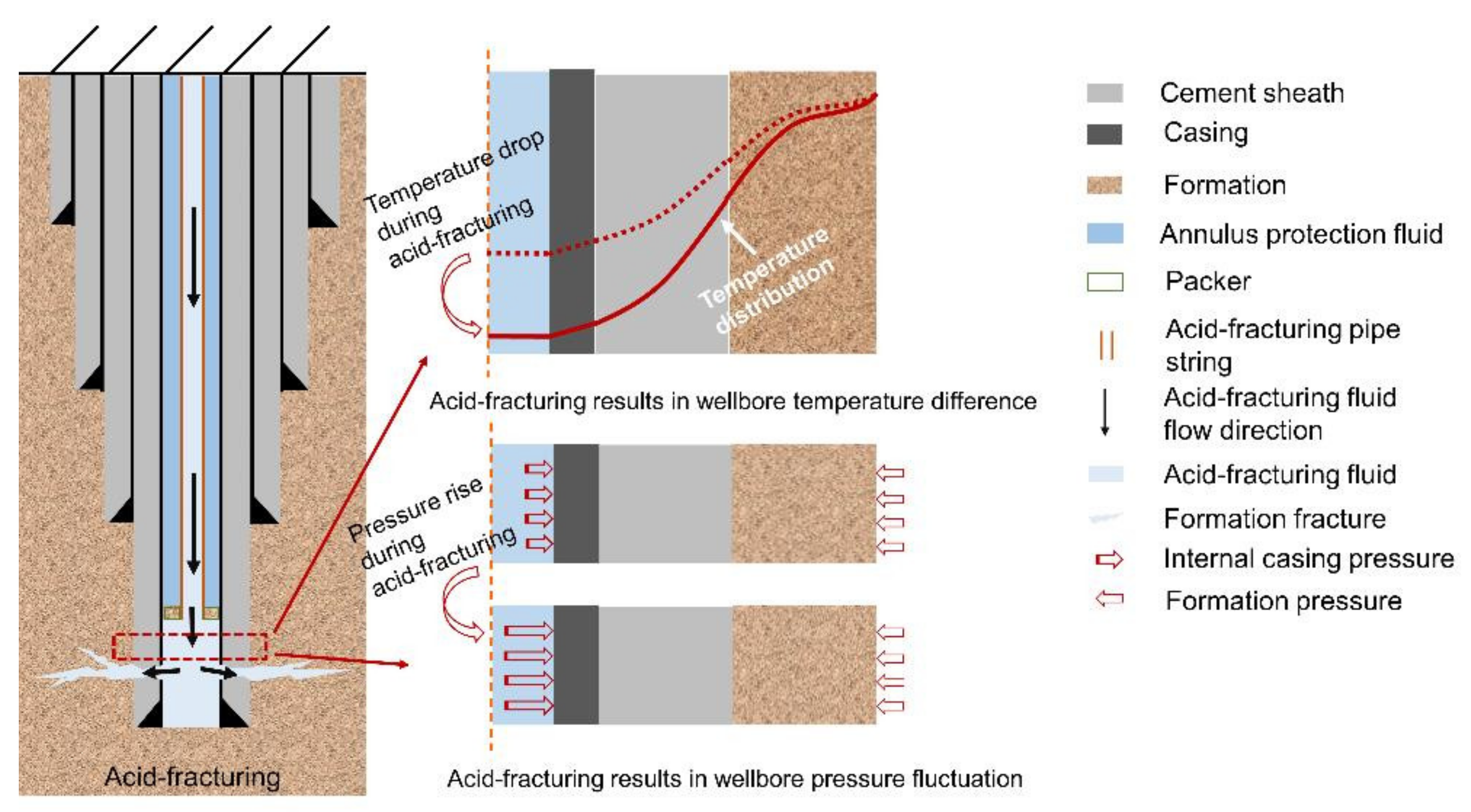
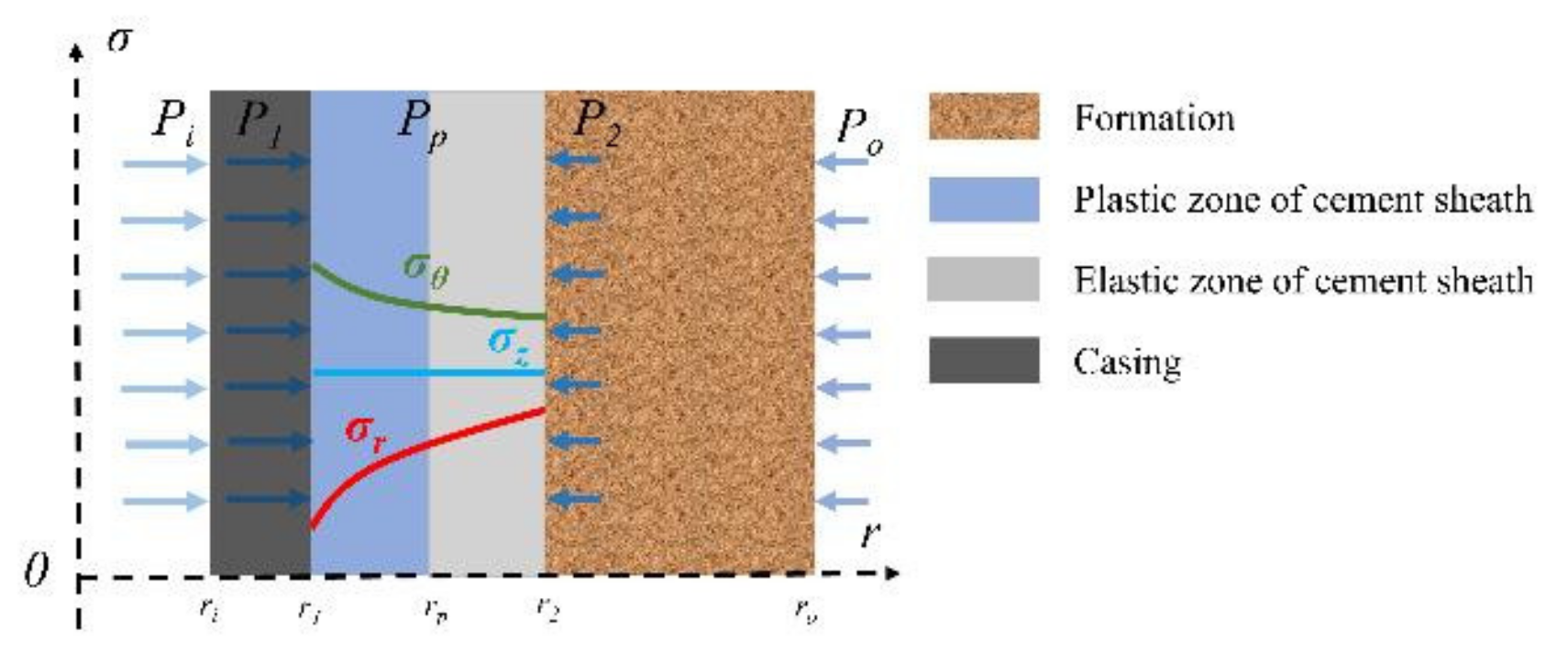
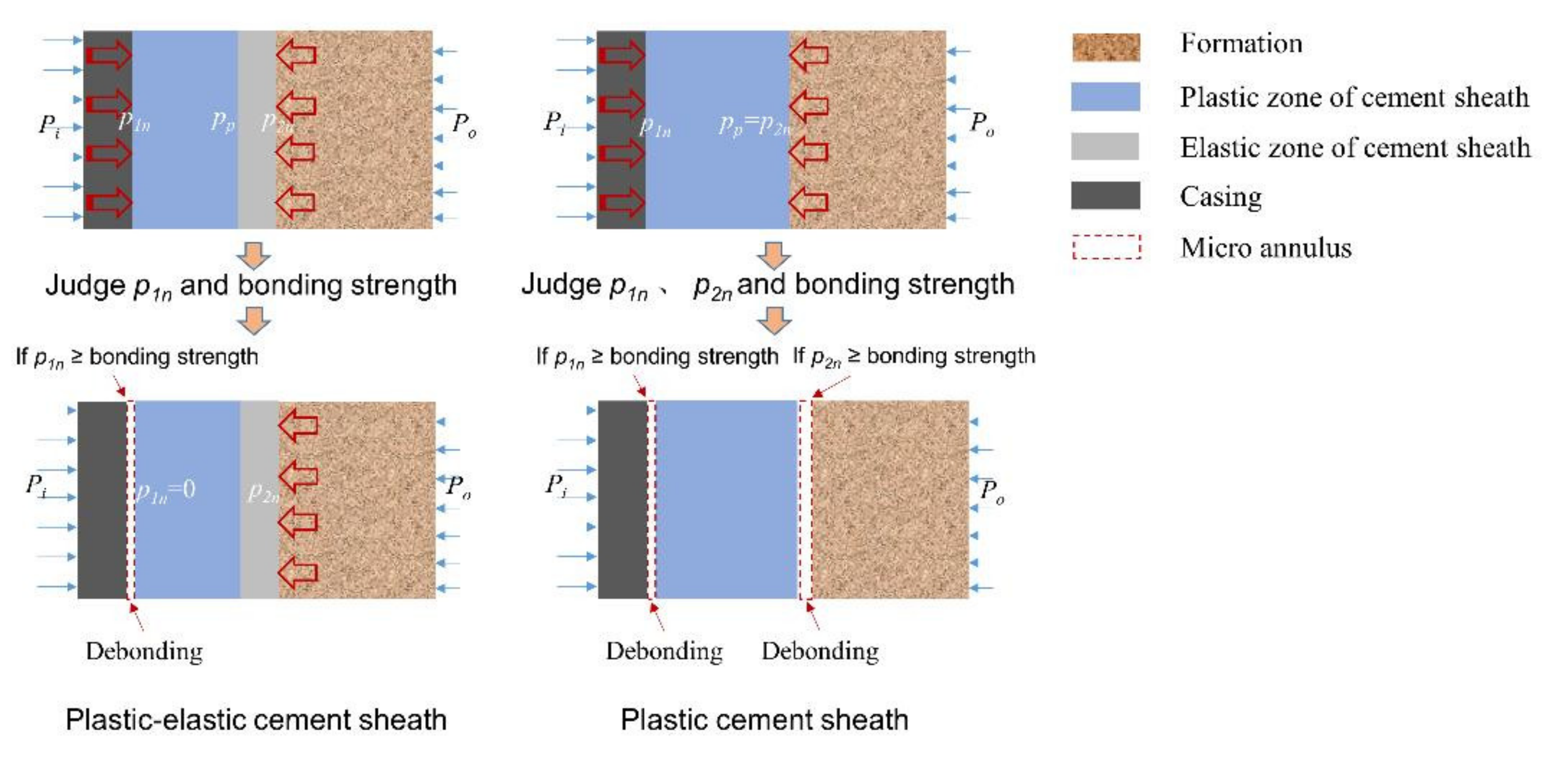
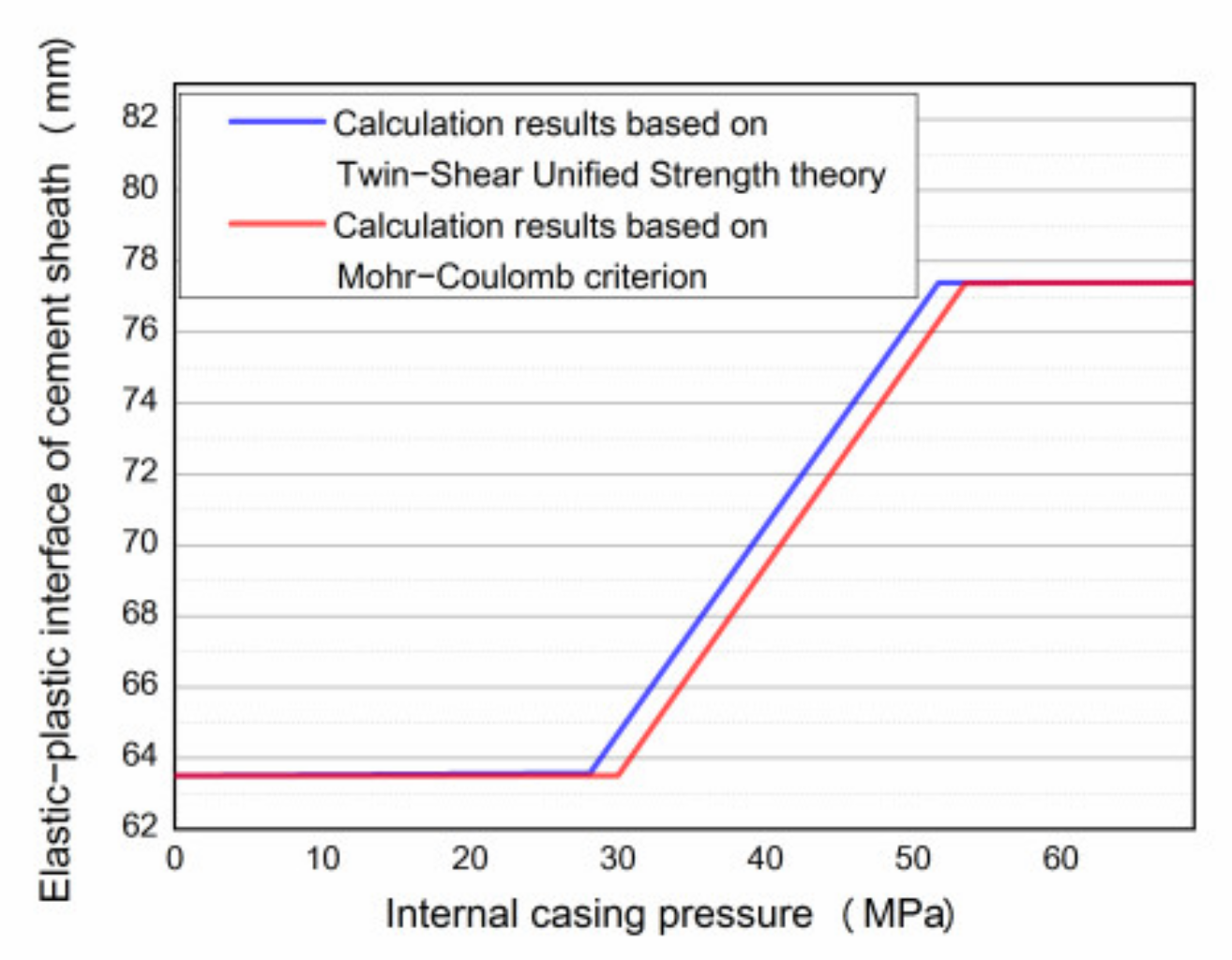

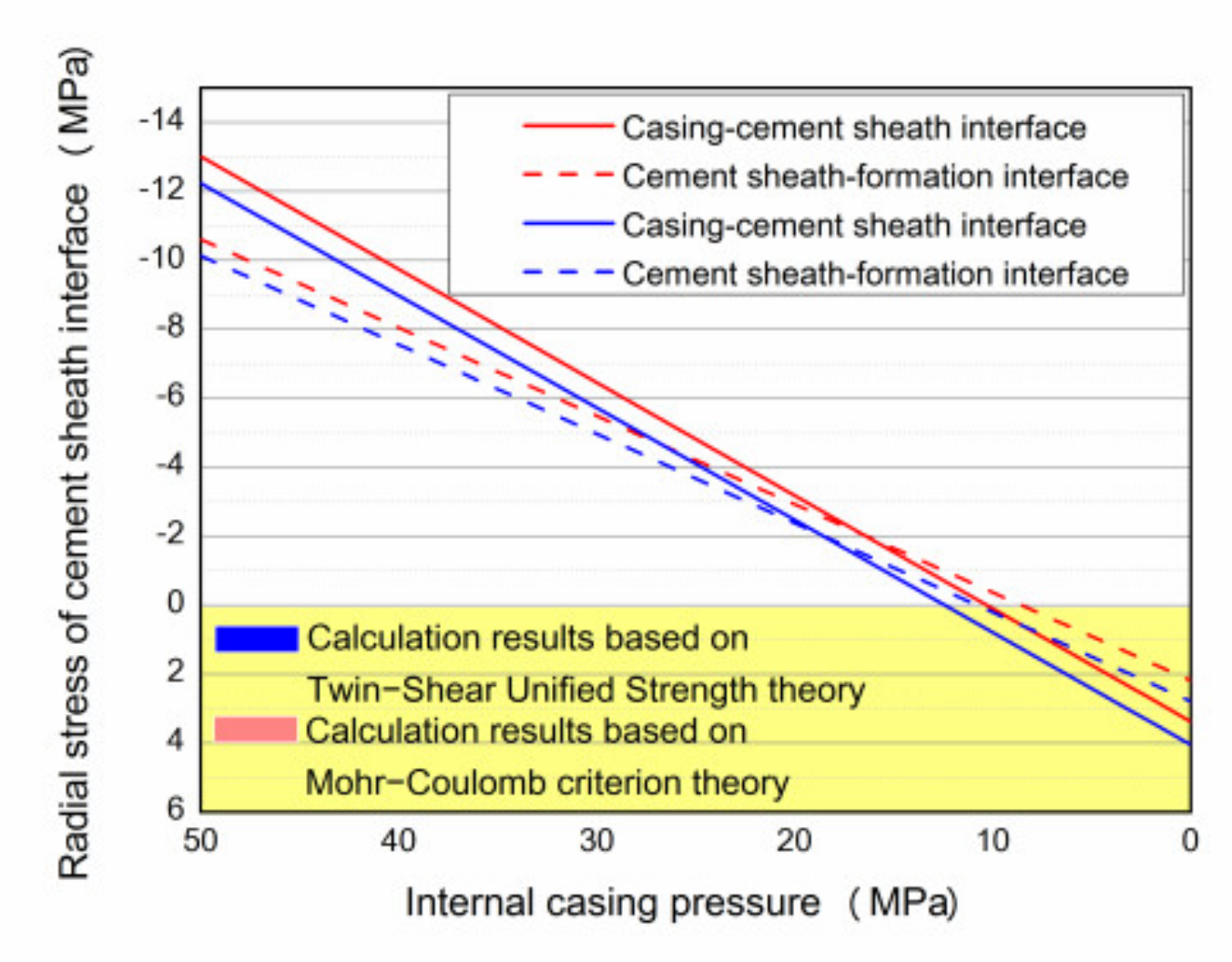

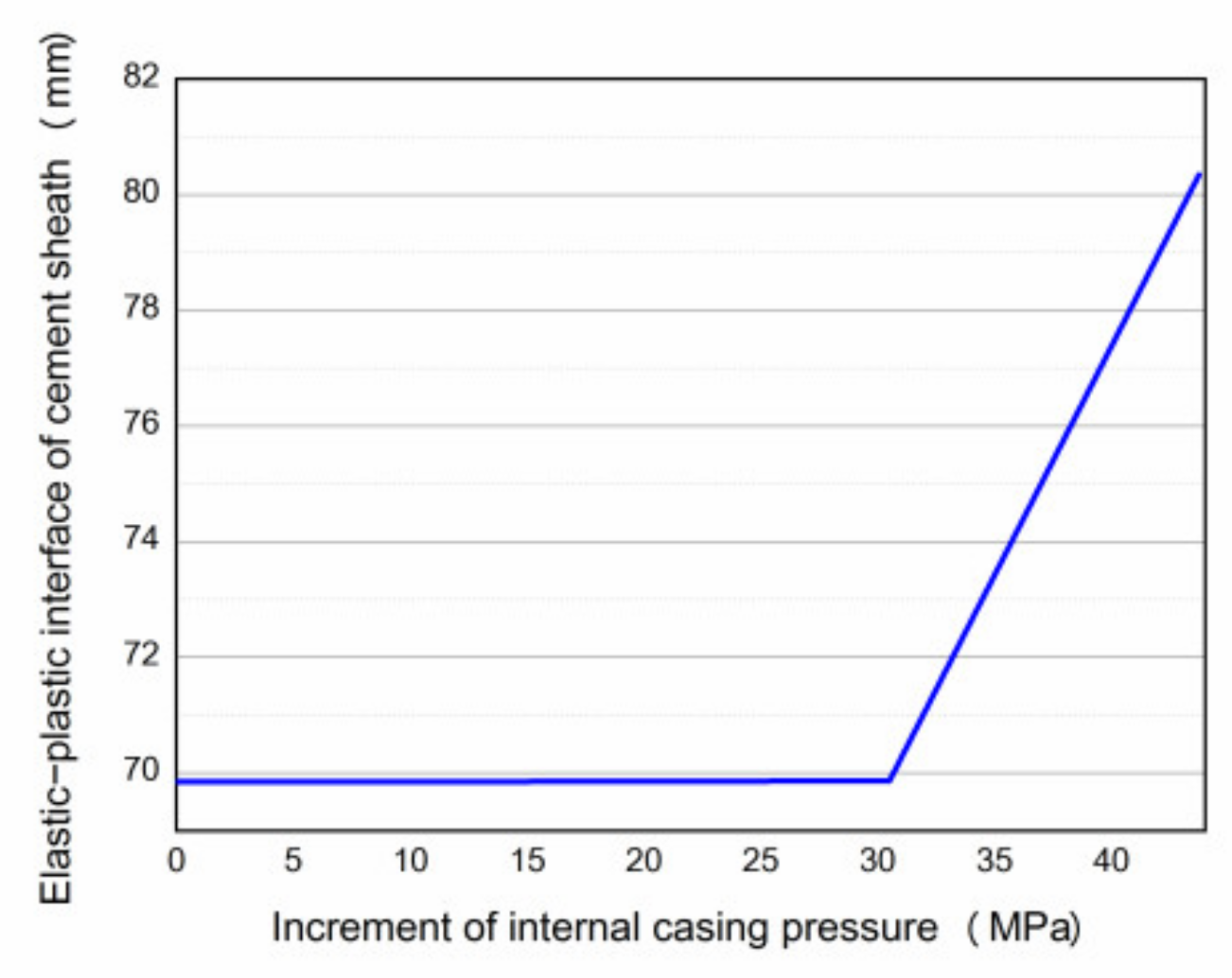
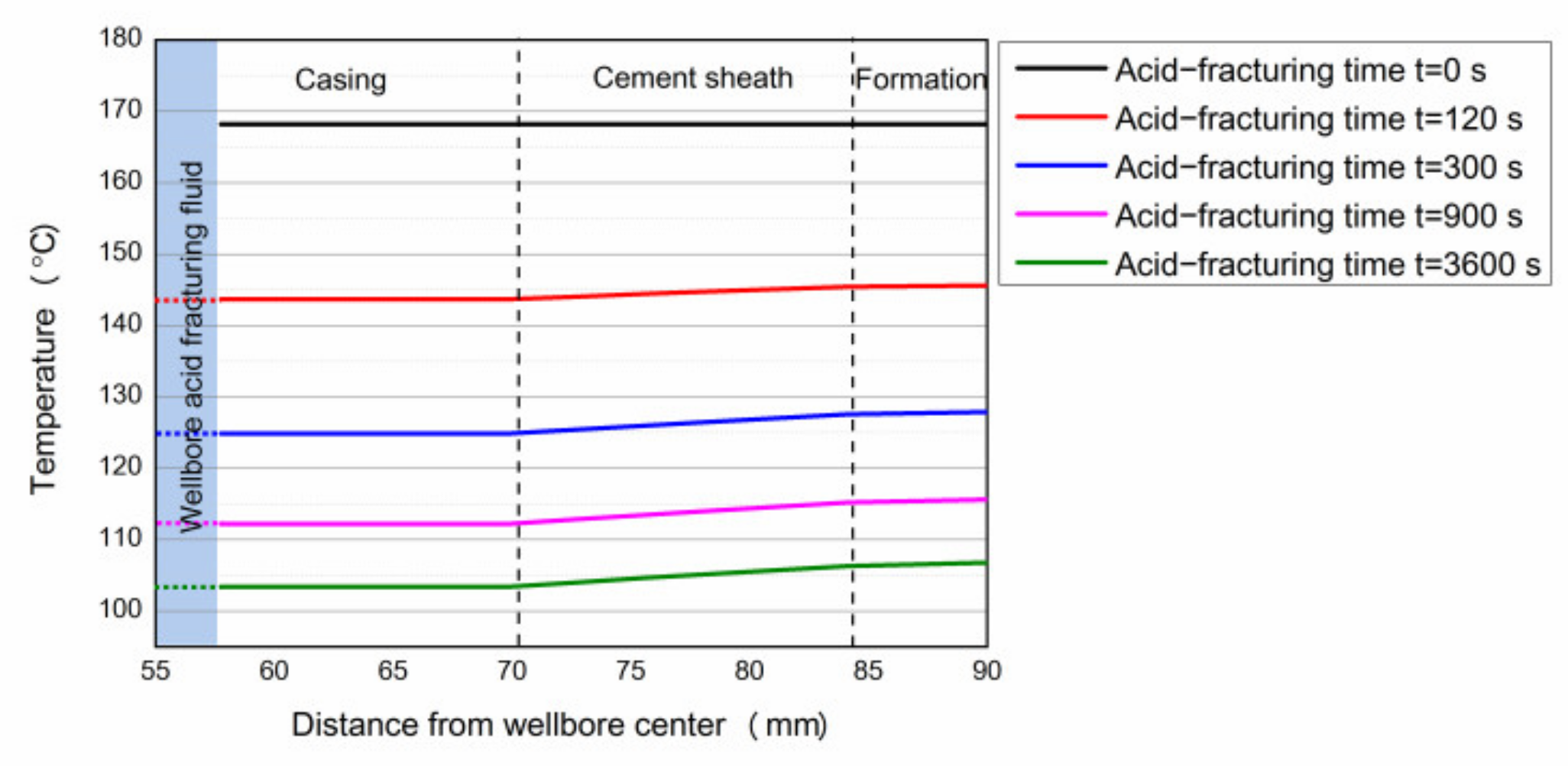


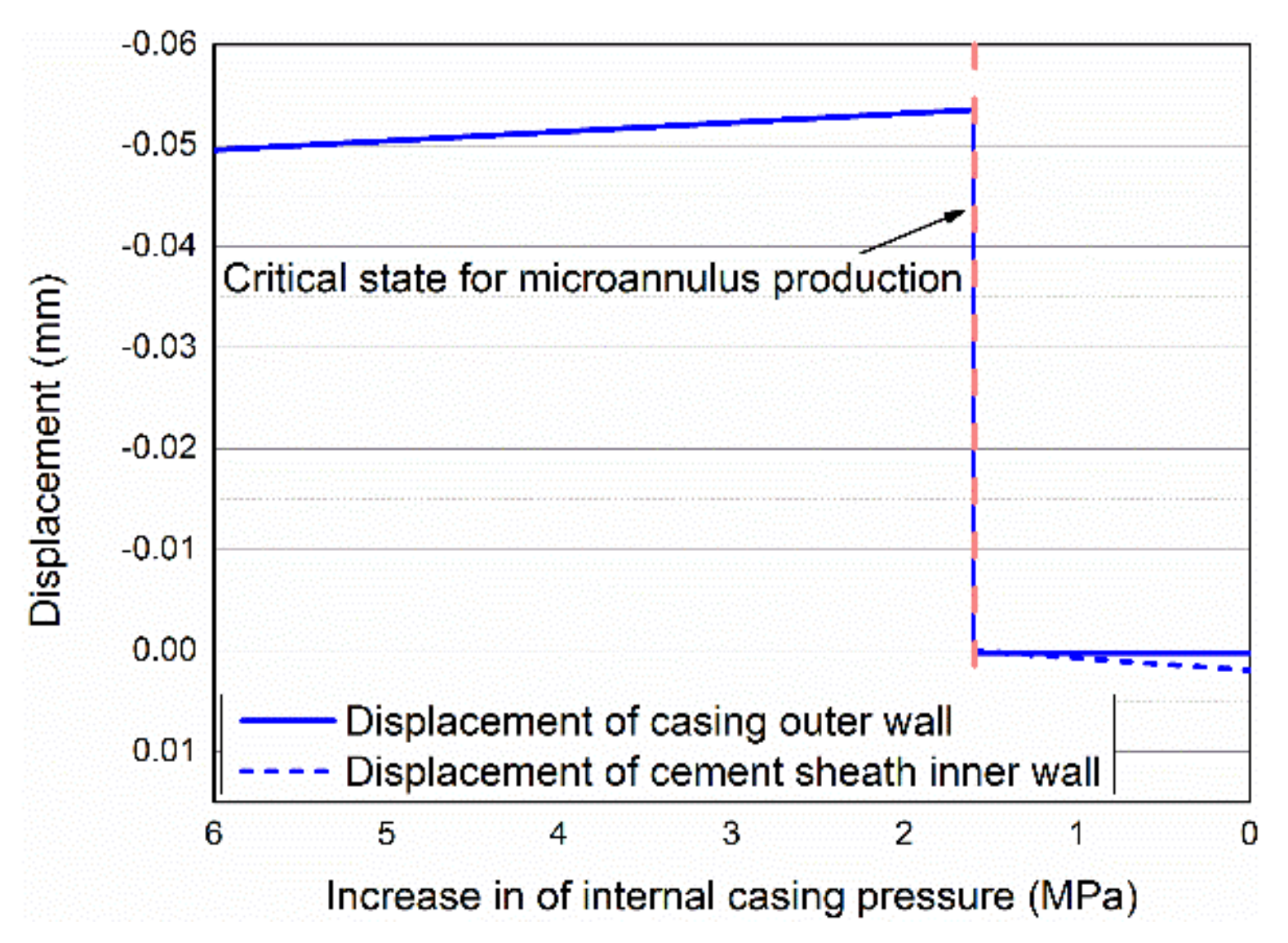
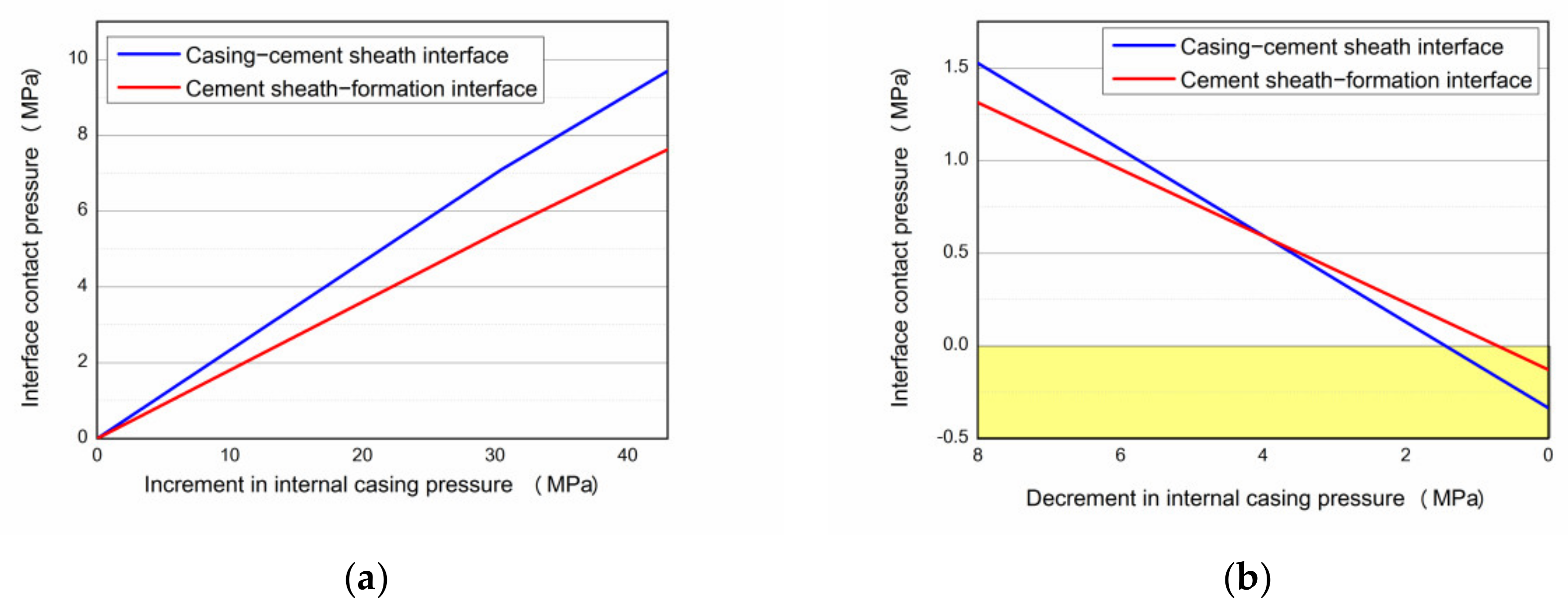
| Inner radius of inner casing (mm) | 54.3 | Outer radius of inner casing (mm) | 63.5 |
| Inner radius of outer casing (mm) | 77.39 | Outer radius of outer casing (mm) | 88.9 |
| Casing internal pressure (MPa) | 69 | Casing external pressure (MPa) | 0 |
| Young’s modulus of casing (GPa) | 210 | Poisson’s ratio of casing | 0.3 |
| Young’s modulus of cement sheath (GPa) | 13.8 | Poisson’s ratio of cement sheath | 0.25 |
| Internal friction angle of cement sheath (°) | 30 | Cement sheath cohesion (MPa) | 5.77 |
| Segment | Drill Size (mm) | Casing Size (mm) | Casing Thickness (mm) | Casing Shoe Position (m) | Cement Slurry Back to High (m) |
|---|---|---|---|---|---|
| 1 | 660.4 | 508 | 12.70 | 200 | 0 |
| 2 | 444.5 | 365.13 | 13.88 | 4340 | 0 |
| 3 | 333.4 | 273.05 | 13.84 | 6466 | 0 |
| 4 | 241.3 | 201.7 | 15.12 | 6250 | 6700 |
| 5 | 168.3 | 139.7 | 12.09 | 7040 | 6700 |
| Parameters | Value | Parameters | Value |
|---|---|---|---|
| Thermal expansion coefficient of casing | 1.3 × 10−5 1/°C | Thermal expansion coefficient of cement sheath | 1.5 × 10−5 1/°C |
| Thermal expansion coefficient of formation | 7 × 10−5 1/°C | Young’s modulus of casing | 210,000 MPa |
| Poisson’s ratio of casing | 0.3 | Young’s modulus of cement sheath | 13,800 MPa |
| Poisson’s ratio of cement sheath | 0.25 | Young’s modulus of formation | 29,500 MPa |
| Poisson’s ratio of formation | 0.33 | Cement sheath bond strength | 4 MPa |
Publisher’s Note: MDPI stays neutral with regard to jurisdictional claims in published maps and institutional affiliations. |
© 2022 by the authors. Licensee MDPI, Basel, Switzerland. This article is an open access article distributed under the terms and conditions of the Creative Commons Attribution (CC BY) license (https://creativecommons.org/licenses/by/4.0/).
Share and Cite
Su, D.; Wu, X.; Li, Z.; Huang, S.; Li, J.; Sun, J.; Zheng, G. Theoretical Analysis of the Micro Annulus of an Oil-Well Cement Sheath Formed via Cooling under Acid-Fracturing Conditions. Processes 2022, 10, 966. https://doi.org/10.3390/pr10050966
Su D, Wu X, Li Z, Huang S, Li J, Sun J, Zheng G. Theoretical Analysis of the Micro Annulus of an Oil-Well Cement Sheath Formed via Cooling under Acid-Fracturing Conditions. Processes. 2022; 10(5):966. https://doi.org/10.3390/pr10050966
Chicago/Turabian StyleSu, Donghua, Xuning Wu, Zaoyuan Li, Sheng Huang, Jin Li, Jinfei Sun, and Guanyi Zheng. 2022. "Theoretical Analysis of the Micro Annulus of an Oil-Well Cement Sheath Formed via Cooling under Acid-Fracturing Conditions" Processes 10, no. 5: 966. https://doi.org/10.3390/pr10050966






